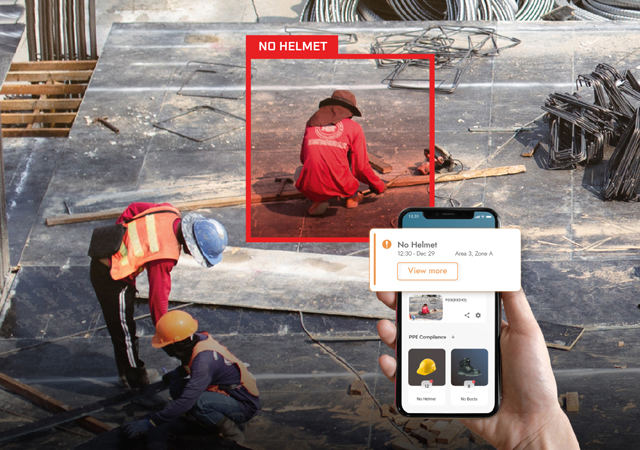
 Video analytics is increasingly being used for site surveillance and inspection.
Video analytics is increasingly being used for site surveillance and inspection.
The GCC and Asia are poised for a paradigm shift in construction, driven by unprecedented innovation and transformative practices, says leading construction technology company viAct which predicts a seamless blend of technology and tradition that will shape striking, sustainable, and efficient structures.
The Hong Kong-based company identifies a number of trends that are poised to reshape the region's construction landscape, ranging from ground-breaking innovations in automation to transformative advancements in project management.
In a bid to guide industry players through the evolving terrain of technological progress, viAct examines five emerging trends in the construction space that promise to shape construction technology in the short to medium term:
• Artificial Intelligence (AI) for project planning: The integration of AI for project planning is emerging as a transformative trend within the construction industry in Asia and the GCC. AI is being increasingly employed to revolutionise project planning processes, offering unparalleled capabilities in data analysis, pattern recognition, and predictive modelling. AI algorithms analyse vast datasets related to project timelines, resource allocation, and historical performance, enabling more accurate forecasting of project milestones and potential risks. This results in optimised scheduling, improved resource utilisation, and enhanced decision-making for construction project managers.
• Video analytics for site surveillance and inspection: Leveraging advanced computer vision technologies, video analytics involves the analysis of video footage from construction sites, enabling automated monitoring, anomaly detection and real-time insights. Video analytics enhances traditional inspection processes in Asia and the GCC, providing a comprehensive and efficient means of gathering data. This technology is pervading the region in different forms such as AI-enabled Project Control Centers (PCC), and Smart Site Safety Systems (SSSS) in Saudi Arabia and Hong Kong. The integration of video analytics would boost tech-driven construction practices, fostering enhanced project oversight and risk management.
 |
|
Hugo Cheuk |
• Generative AI for project collaboration: There is set to be a spike in the transformative deployment of generative AI across the GCC and Asia, specifically in the construction industry. This innovative technology fosters enhanced project collaboration by dynamically generating real-time solutions for on-site challenges. Leveraging data from various sources, generative AI optimises resource allocation, facilitates seamless communication among project stakeholders, and adapts construction plans to unforeseen circumstances. The technology’s ability to quickly analyse and propose alternatives streamlines decision-making, improving overall project efficiency. From optimising workflows to foreseeing potential bottlenecks, generative AI stands at the forefront of fostering collaboration during the construction phase, paving the way for a more agile and responsive construction industry.
• IoT wearables for smart risk management: This year is expected to see a surge in use of IoT wearables in the construction realm, revolutionising risk management for EHS teams. These devices, equipped with sensors and connectivity, offer real-time monitoring of workers engaged in tasks within confined spaces and working at height. By collecting and analysing data on environmental conditions, movement patterns, and vital signs, IoT wearables ensure proactive risk mitigation. The technology enhances safety protocols in critical construction activities in risk-prone areas by providing instant alerts. These alerts act as crucial insights for swift response to potential hazards, fostering a smarter and safer construction environment in the region.
• Predictive analytics for sustainable lifecycle: The integration of Large Language Models (LLM) is another emerging trend in construction technology.
By redefining predictive analytics, decision-making processes would be made more intelligent through a data-driven approach to sustainable construction practices in the large construction landscapes of the GCC and Asia. Leveraging advanced algorithms like LLMs, predictive analytics anticipates potential challenges throughout the construction process, optimising resource utilisation and minimising environmental impact. These models analyse vast datasets, offering insights into material requirements, energy consumption, and equipment maintenance needs. By predicting and addressing issues proactively, construction projects can enhance efficiency, reduce waste, and align with sustainability goals.
“There is a dawn of a new era in the construction landscape across Asia and the GCC,” says Hugo Cheuk, COO of viAct. “The paradigm is shifting towards unprecedented innovation and transformative practices. The traditional meets the cutting-edge, and we stand at the forefront of this evolution. This marks a pivotal moment where technology seamlessly blends with tradition, shaping sustainable, efficient, and remarkable structures.”
Cheuk says viAct is committed not just to change skylines, but also to redefine the very essence of construction. The company’s overview of transformative technology trends in Asia & GCC; are outlined in its report “Building Beyond: Trends of Generative AI & LLM in Construction for 2024” reflecting how the sector is moving towards intelligent, eco-conscious, and ground-breaking construction methodologies for a resilient future.





















_0001.jpg)


.jpg)
















.jpg)








.jpg)


